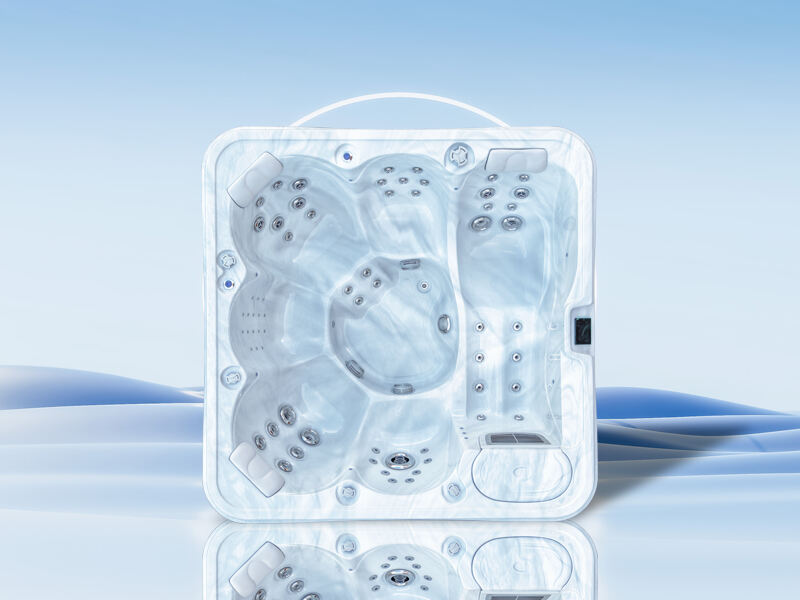Determining Your Swim Spa's Primary Purpose
Clarifying your swim spa's core function eliminates unnecessary costs while ensuring alignment with lifestyle goals. A 2023 ISPA report shows 60% of buyers prioritize fitness features, while 30% prioritize therapeutic applications.
Fitness-Focused vs. Therapeutic Swim Spa Needs
Fitness-driven users require adjustable current systems capable of sustaining 15–20 minute swim sessions. Therapeutic models prioritize hydrotherapy jet configurations, targeting muscle groups with pressures exceeding 60 PSI. Hybrid units now dominate 55% of sales by offering both modalities through partitioned zones.
Family Use Requirements and Multifunctional Design
For households, prioritize seating capacity (6–8 seats) with staggered depths (3.5'–5') to accommodate adults and children. Non-slip steps and bench-style seating reduce injury risks while enabling social interaction. APSP 2024 data shows 45% of family buyers prioritize integrated entertainment (Bluetooth® audio, LED lighting).
Swim Spa Size and Capacity Considerations
Balancing user requirements with spatial constraints forms the foundation of swim spa sizing decisions. Most residential models range from 12' to 19' long, with 80% of installations requiring at least 3' of clearance on all sides for maintenance access.
User Number vs. Available Installation Space
Compact 12'-14' models accommodate 1-4 users effectively, ideal for couples or small families. For households regularly hosting 4+ swimmers, 16'-17' designs provide critical extra space without dominating standard backyard layouts.
Water Depth Requirements for Effective Swimming
The optimal 48"-52" depth range supports proper stroke mechanics while allowing foot clearance from floor jets. Taller users (>6') should prioritize spas with ≥50" depths to avoid restricted kick patterns—a common contributor to swim-related injuries.
Evaluating Swim Spa Features and Systems
Adjustable Current Technology in Swim Spas
Adjustable current technology allows users to modify water flow from 2-10 mph. High-efficiency propulsion systems maintain current consistency within ±5% variance, crucial for effective lap swimming.
Hydromassage Jet Configurations and Therapy Options
Therapeutic swim spas deploy 30-70 strategically placed jets, with rotating nozzle designs offering 15-100 PSI pressure ranges. Dual-zone systems allow simultaneous high-intensity leg therapy and gentle upper-body massage.
Filtration Systems and Water Circulation Efficiency
Advanced filtration combines 35-micron cartridge filters with ozone purification, reducing chemical use by 34%. Variable-speed circulation pumps process 100% of water every 11 minutes, operating 22% more efficiently than single-speed counterparts.
Energy Efficiency in Swim Spa Operations
Insulation Quality and Heating Costs Analysis
High-density foam insulation reduces heat loss by 40%, cutting monthly heating expenses to $85–$120. Thermal covers with 4–6 R-values extend heat retention by 3–5 hours daily.
Variable-Speed Pumps for Power Savings
Variable-speed pumps adapt motor output to real-time flow demands, reducing swim spa energy use by 55–75%. A 5-hp pump operating at 50% speed saves $300–$450 annually. Prioritize units with ENERGY STAR® certification.
Swim Spa Budget and Financing Strategies
Upfront Costs vs. Long-Term Ownership Expenses
Swim spa prices range from $15,000 to over $50,000 in 2024. Beyond the initial purchase, owners should budget $1,500–$3,500 annually for operational costs. High-efficiency models reduce heating costs by up to 30%.
Lease vs. Purchase Options for Swim Spas
Three primary financing pathways exist:
- Dealership financing (36–60-month terms, 5–12% APR)
- Home equity lines of credit (4–8% interest)
- Third-party leasing ($250–$600/month)
Assessing Swim Spa Brands and Warranties
Manufacturer Reputation and Industry Certifications
Prioritize manufacturers with NSF/ANSI 50 or APSP certifications. Brands operating for 15+ years show 30% fewer warranty claims.
Comprehensive Coverage vs. Component-Specific Warranties
| Warranty Type | Coverage Scope | Typical Duration |
|---|---|---|
| Comprehensive | Shell, plumbing, jets, electronics | 5–10 years |
| Component-Specific | Individual parts | 1–3 years |
Swim Spa Installation and Maintenance Essentials
Site Preparation Guidelines for Swim Spa Placement
Select a level, reinforced concrete foundation capable of supporting 11,000–15,000 pounds. Ensure the site allows at least 3 feet of clearance on all sides. Electrical requirements typically demand a dedicated 240V circuit.
Seasonal Care Routines for Optimal Performance
Winterization requires draining jets and pumps. Summer maintenance focuses on UV protection—weekly wiping with pH-neutral cleaners prevents oxidation damage.
Water Chemistry Management Best Practices
Maintain pH levels between 7.2–7.8 and sanitizer concentrations of 1–3 ppm bromine or 3–5 ppm chlorine. Weekly digital testing reduces chemical imbalances by 89%.
FAQ
What is the primary purpose of a swim spa?
The primary purpose of a swim spa can vary according to individual needs and preferences, ranging from fitness training to therapeutic relaxation for muscle recovery.
How do swim spa sizes affect user capacity?
Swim spa sizes determine how many users can comfortably fit at one time. Smaller models are ideal for up to 4 users, while larger ones can accommodate more.
What are the key features to look for in a swim spa?
Key features include adjustable currents for fitness, hydrotherapy jets for relaxation, efficient filtration systems, and energy-efficient designs.
Which are the best financing options for purchasing a swim spa?
Financing options include dealership financing, home equity lines of credit, and third-party leasing.
How is swim spa energy efficiency maintained?
Energy efficiency is enhanced with high-density insulation, variable-speed pumps, and ENERGY STAR® certified units.
What maintenance is required for swim spas?
Regular maintenance includes site preparation, seasonal care, and management of water chemistry to ensure optimal performance.
Table of Contents
- Determining Your Swim Spa's Primary Purpose
- Swim Spa Size and Capacity Considerations
- Evaluating Swim Spa Features and Systems
- Energy Efficiency in Swim Spa Operations
- Swim Spa Budget and Financing Strategies
- Assessing Swim Spa Brands and Warranties
- Swim Spa Installation and Maintenance Essentials
- FAQ

